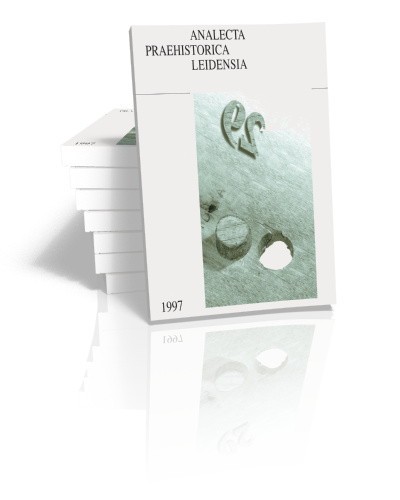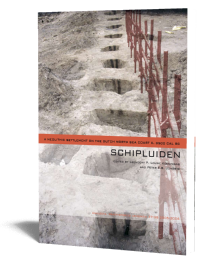Ideology and Social Structure of Stone Age Communities in Europe
Also including: Wateringen 4 & Acquiring a taste
Edited by Annelou van Gijn, Corrie Bakels & Marek Zvelebil | 1997

Ideology and Social Structure of Stone Age Communities in Europe
Also including: Wateringen 4 & Acquiring a taste
Edited by Annelou van Gijn, Corrie Bakels & Marek Zvelebil | 1997
Paperback ISBN: 9789073368118 | Imprint: Distributed Title - Published by the Modderman Stichting / Faculty of Archaeology - Leiden University | Format: 210x265mm | 210 pp. | Analecta Praehistorica Leidensia 29 | Series: Analecta | Language: English | Keywords: archaeology, prehistory, neolithic, social structure, neolithisation | download cover
Read online or downloaded 2607 times
-
Digital & Online access
This is a full Open Access publication, click below to buy in print, browse, or download for free.
-
Buy via Sidestone (EU & UK)
-
Buy via our Distributors (WORLD)
This title is not available via our UK or USA distributors. You can place an order above in the EU section. We can ship worldwide, shipping costs will be added during ordering based on destination.
-
Bookinfo
Paperback ISBN: 9789073368118 | Imprint: Distributed Title - Published by the Modderman Stichting / Faculty of Archaeology - Leiden University | Format: 210x265mm | 210 pp. | Analecta Praehistorica Leidensia 29 | Series: Analecta | Language: English | Keywords: archaeology, prehistory, neolithic, social structure, neolithisation | download cover
Read online or downloaded 2607 times

We will plant a tree for each order containing a paperback or hardback book via OneTreePlanted.org.
This volume contains the edited volume “Ideology and Social Structure of Stone Age Communities in Europe” as well as two added papers “Wateringen 4: a settlement of the Middle Neolithic Hazendonk 3 Group in the Dutch” and “Acquiring a taste: the menu of Iron Age and Roman period farmers in Oss-Ussen, the Netherlands”.
Ideology and social structure of stone age communities in Europe
This volume is the result of a conference held at the Netherlands Institute for Advanced Studies, Wassenaar, Holland, on April 28 and 29, 1994. The subject of the conference focussed on the social organisation and ideology of the stone age communities in Europe during the later Mesolithic and Neolithic periods (ca. 8000-4000 BP).
The questions of social structure, social organisation and ideology of hunting and gathering and early farming communities in the stone age are becoming increasingly central to our understanding of these societies and of their transformations. This realisation has provoked a lively debate on the subject in recent publications. At the same time, many archaologists and prehistorians approach this question from the position of their own period of research (either Mesolithic or Neolithic), and/or from the point of view of a particular paradigm they favour. This has resulted in many conflicting views which provide a polemical background to the subject of the volume.
The contributions to the volume focussed on three particular questions: 1) what do we know about the social organisation and ideology of these societies today, 2) how can we use archaeological evidence and our conceptual frameworks to gain greater knowledge of the social domain of the Mesolithic and Neolithic societies, 3) what patterns of social change attend the Mesolithic-Neolithic transition?
“Annelou van Gijn & Marek Zvelebil: Preface
Annelou van Gijn & Marek Zvelebil: Stone age, ideology and scaling the ladder of inference
Richard Bradley: Domestication as a state of mind
Ivana Radovanovic & Barbara Voytek: Hunters, fishers or farmers: sedentism, subsistence and social complexity in the Djerdap Mesolithic
Marek Zvelebil: Hunter-gatherer ritual landscapes: spatial organisation, social structure and ideology among hunter-gatherers of Northern Europe and Western Siberia
Kristina Jennbert: Mentality and the social world: the Mesolithic-Neolithic transition in Southern Scandinavia
Julian Thomas: The materiality of the Mesolithic-Neolithic transition in Britain
Leo Verhart & Milco Wansleeben: Waste and prestige: the Mesolithic-Neolithic transition in the Netherlands from a social perspective
Torsten Madsen: Ideology and social structure in the earlier Neolithic of South Scandinavia: a view from the sources
Piet van de Velde: Much ado about nothing: Bandkeramik funerary ritual
Marjorie de Grooth: Social and economic interpretations of the chert procurement strategies of the Bandkeramik settlement at Hienheim, Bavaria
Mark Edmonds: Taskscape, technology and tradition
John O’Shea: A portrait of ancient society on the South Hungarian Plain
John Barrett: Stone age ideologies
Douglas Lewis: Remarks on the problem on inferring ideology and social structure from the artifacts of human action
Also included:
Wateringen 4: a settlement of the Middle Neolithic Hazendonk 3 Group in the Dutch coastal area
by: D.C.M. Raemaekers Wateringen, C.C. Bakels, B. Beerenhout, A.L. van Gijn, K. Hänninen, S. Molenaar, D. Paalman, M. Verbruggen &
C. Vermeeren
Acquiring a taste: the menu of Iron Age and Roman period farmers in Oss-Ussen, the Netherlands
by: Corrie Bakels, Dieke Wesselingh & Ilse van Amen

Prof. dr. Annelou van Gijn
Annelou van Gijn is professor of Archaeological Material Culture and Artefact Studies at Leiden University and studied anthropology and archaeology at Washington State University Pullman (US) and the University of Groningen. She obtained her PhD at Leiden University. Her teaching and research focus on prehistoric technology, ancient crafts, experimentation and the reconstruction of the cultural biography of objects, topics on which she published widely.

Prof. (em.) Dr. Corrie Bakels
Corrie Bakels has held the chair in palaeoeconomy at Leiden University, the Netherlands, since 1988. Her specialisations are prehistoric and early historic agriculture, archaeobotany and vegetation history. She graduated in 1978 on an analysis of early farming societies in the Netherlands and Bavaria, Germany. Since then she has participated in many archaeological projects in Western Continental Europe. A synthesis of her work on the agrarian history of the Western European loess belt, 5300 BC – AD 1000 has appeared in 2009.
Abstract:
This volume contains the edited volume “Ideology and Social Structure of Stone Age Communities in Europe” as well as two added papers “Wateringen 4: a settlement of the Middle Neolithic Hazendonk 3 Group in the Dutch” and “Acquiring a taste: the menu of Iron Age and Roman period farmers in Oss-Ussen, the Netherlands”.
Ideology and social structure of stone age communities in Europe
This volume is the result of a conference held at the Netherlands Institute for Advanced Studies, Wassenaar, Holland, on April 28 and 29, 1994. The subject of the conference focussed on the social organisation and ideology of the stone age communities in Europe during the later Mesolithic and Neolithic periods (ca. 8000-4000 BP).
The questions of social structure, social organisation and ideology of hunting and gathering and early farming communities in the stone age are becoming increasingly central to our understanding of these societies and of their transformations. This realisation has provoked a lively debate on the subject in recent publications. At the same time, many archaologists and prehistorians approach this question from the position of their own period of research (either Mesolithic or Neolithic), and/or from the point of view of a particular paradigm they favour. This has resulted in many conflicting views which provide a polemical background to the subject of the volume.
The contributions to the volume focussed on three particular questions: 1) what do we know about the social organisation and ideology of these societies today, 2) how can we use archaeological evidence and our conceptual frameworks to gain greater knowledge of the social domain of the Mesolithic and Neolithic societies, 3) what patterns of social change attend the Mesolithic-Neolithic transition?
Contents
“Annelou van Gijn & Marek Zvelebil: Preface
Annelou van Gijn & Marek Zvelebil: Stone age, ideology and scaling the ladder of inference
Richard Bradley: Domestication as a state of mind
Ivana Radovanovic & Barbara Voytek: Hunters, fishers or farmers: sedentism, subsistence and social complexity in the Djerdap Mesolithic
Marek Zvelebil: Hunter-gatherer ritual landscapes: spatial organisation, social structure and ideology among hunter-gatherers of Northern Europe and Western Siberia
Kristina Jennbert: Mentality and the social world: the Mesolithic-Neolithic transition in Southern Scandinavia
Julian Thomas: The materiality of the Mesolithic-Neolithic transition in Britain
Leo Verhart & Milco Wansleeben: Waste and prestige: the Mesolithic-Neolithic transition in the Netherlands from a social perspective
Torsten Madsen: Ideology and social structure in the earlier Neolithic of South Scandinavia: a view from the sources
Piet van de Velde: Much ado about nothing: Bandkeramik funerary ritual
Marjorie de Grooth: Social and economic interpretations of the chert procurement strategies of the Bandkeramik settlement at Hienheim, Bavaria
Mark Edmonds: Taskscape, technology and tradition
John O’Shea: A portrait of ancient society on the South Hungarian Plain
John Barrett: Stone age ideologies
Douglas Lewis: Remarks on the problem on inferring ideology and social structure from the artifacts of human action
Also included:
Wateringen 4: a settlement of the Middle Neolithic Hazendonk 3 Group in the Dutch coastal area
by: D.C.M. Raemaekers Wateringen, C.C. Bakels, B. Beerenhout, A.L. van Gijn, K. Hänninen, S. Molenaar, D. Paalman, M. Verbruggen &
C. Vermeeren
Acquiring a taste: the menu of Iron Age and Roman period farmers in Oss-Ussen, the Netherlands
by: Corrie Bakels, Dieke Wesselingh & Ilse van Amen

Prof. dr. Annelou van Gijn
Annelou van Gijn is professor of Archaeological Material Culture and Artefact Studies at Leiden University and studied anthropology and archaeology at Washington State University Pullman (US) and the University of Groningen. She obtained her PhD at Leiden University. Her teaching and research focus on prehistoric technology, ancient crafts, experimentation and the reconstruction of the cultural biography of objects, topics on which she published widely.

Prof. (em.) Dr. Corrie Bakels
Corrie Bakels has held the chair in palaeoeconomy at Leiden University, the Netherlands, since 1988. Her specialisations are prehistoric and early historic agriculture, archaeobotany and vegetation history. She graduated in 1978 on an analysis of early farming societies in the Netherlands and Bavaria, Germany. Since then she has participated in many archaeological projects in Western Continental Europe. A synthesis of her work on the agrarian history of the Western European loess belt, 5300 BC – AD 1000 has appeared in 2009.
-
Digital & Online access
This is a full Open Access publication, click below to buy in print, browse, or download for free.
-
Buy via Sidestone (EU & UK)
-
Buy via our Distributors (WORLD)
This title is not available via our UK or USA distributors. You can place an order above in the EU section. We can ship worldwide, shipping costs will be added during ordering based on destination.
- Browse all books by subject
-
Search all books

We will plant a tree for each order containing a paperback or hardback book via OneTreePlanted.org.
You might also like:
© 2025 Sidestone Press KvK nr. 28114891 Privacy policy Sidestone Newsletter Terms and Conditions (Dutch)







